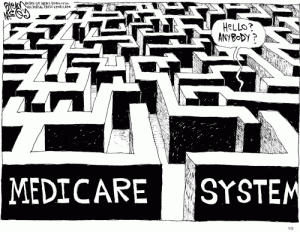By Jack Cumming
Brookdale was once the mighty giant of senior living with a valuation to match. Today, the company has shrunk and its valuation is a fraction of what it once was. Along the way, there was a huge merger with Emeritus, activist investors wanting to extract the real estate, and a major management shift to try to reverse the downward spiral.
Corporate Controversy
Two controversies have enveloped the enterprise and created a distraction for management. In the first, the merger with Emeritus proved more difficult than expected. The cultures and pricing algorithms of the two enterprises were very different. There was a move to try to rebrand the merged properties with the Brookdale identity. Leadership turnover and lagging occupancy resulted, and the expected gains from the merger never materialized.
The second controversy has come to be called PropCo-OpCo. The idea is to separate the real estate holdings (PropCo) from operations (OpCo). Two activist investors have called on Brookdale to spin its real estate off into a separate company. The first, Tom Sandell of Sandell Asset Management made his proposal in February 2015, less than a year after the Emeritus merger when Brookdale shares were trading at about $35. Sandell estimated then that a spinoff could increase the share value to $49. Sandell sold its entire stake in Brookdale a little more than a year after making its proposal.
More recently, a second activist investor, Jonathan Litt of Land and Buildings, has made a similar proposal, now estimating that the spinoff would result in a combined company share price of $13.60 ($10.30 for PropCo and $3.30 for OpCo) compared with a recent Brookdale share price of under $8. This time Brookdale’s Board pushed back. Swedish-born Sandell is a New York City hedge fund investor, while Land and Buildings, located in Stamford, CT, concentrates on real estate.
“Win Locally”
Lost in all this activism is service to the ultimate consumer, the aging people who need the supportive services in which Brookdale specializes. Brookdale CEO, Cindy Baier, has made improving services, what opportunistic investors might call OpCo, the centerpiece of her leadership. Recently, Baier was quoted as saying that “being caring and genuinely caring about our residents is the most important thing”. She calls the program to rejuvenate the company “win locally” in the expectation that empowering local managers can give the culture the vibrancy and unity needed to grow occupancy, to reduce move-outs, and to build value by improving treatment of customers and employees.
The outside opportunistic activism calls to mind the television program, “Shark Tank”. A recent article described how the popularity of “Shark Tank” has changed business school curricula to respond to the growing interest in entrepreneurship. “Shark Tank” confines its sharp evaluations though to startup ventures. Missing is a comparable popular television program showing how outside investors look at established businesses.
Disrupt or Be Disrupted
Just as venture capitalists were plying their trade long before “Shark Tank” popularized their clear cold scrutiny of startups, so activists are today seeking to address latent value within established businesses. While the activists now plaguing Brookdale’s management may have it wrong, all businesses can benefit from the kind of clear-eyed strategic criticism that the “sharks” bring to startups. We use the term “disruption” to describe these opportunities to improve customer value by revolutionizing established business models.
In some industries, the watchword has become, “disrupt or be disrupted”. That is not yet true for senior living. Disruption involves the combination of market perception with imagination and sufficient capital to change the established order. It often comes from startups, most of which however fail, though it’s possible for established businesses to disrupt their own business practices. Just saying that, though, reveals that it is risky and large enterprises tend to become risk-averse.
One takeaway from the activist interest in Brookdale is that smart money senses some kind of imminent disruption in senior living. That’s why the industry attracts the attention of people like Sandell and Litt even if their proposals seem unworkable. The real estate ploy can’t work to increase value because the approach is to increase lease costs to the OpCo, thereby maximizing PropCo investment returns, while making OpCo less competitive. Since all revenue starts with a customer, handicapping the OpCo is a self-destructive strategy.
Customers First
Brookdale’s Ms. Baier is taking an incremental approach. Her concept is to restore customer satisfaction at the local level and that will enhance the local reputation and slowly build local success. Local successes can then aggregate nationwide to enterprise success. It’s reminiscent of the old Smith Barney slogan, intoned by John Houseman, “They make money the old-fashioned way . . . they earn it.”
The times are changing, though. If it were easy to foresee the future of senior living, everyone would be doing it and no one would have to fear disruption. The model, though, that appeals the most me, is to allow people to continue living where they are until they decide in their own good time that they want to move into a congregate setting. It strikes me that this fits the PACE (Program of All-Inclusive Care for the Elderly) concept the best. That program, though, is, for now, limited to the indigent.
With PACE, people enter into a relationship in which the provider entity responds to their needs as they eventuate, whether the need is as simple as screwing on a new toilet seat or as complex as hospital confinement. PACE participants agree to receive all their medical services from the PACE provider, similar to what Medicare Advantage participants agree to, but the PACE programs are more integrated and more extensive.
PACE for the Affluent
PACE programs do not typically include housing, though one can imagine a model in which participants would transition from independent living toward congregate living as their needs increase. If the PACE concept were extended to the affluent, then we can imagine people choosing a PACE affiliation early on, much as they might now begin attending events at a local Senior Center. Such a coordinated PACE-like program could serve as a feeder to care-oriented organizations like Brookdale.
Is this a model that might help Brookdale, for instance, to disrupt its own existing business models? It might. It would take a pilot test in a selected area to prove or disprove the concept. Is this the kind of far-ranging idea that Brookdale should pursue, alongside its “win locally” efforts to improve the experience of its employees, current residents, and their families? Probably, though there’s no reason why other providers might not act first. What’s the significance of this potentially disruptive example and others like it? This is the kind of idea that might allow a well-funded start-up to begin to draw traffic away from the conventional senior living industry.
Turnaround Activist
Remember our suggestion that a TV offering called, say, “Turnaround Specialist” might bring to established businesses the kind of critical scrutiny that “Shark Tank” brings to startups? The PACE idea is but one such idea. Others might be a resident ownership model or an assertive automation concept. Industries tend to recognize disruptive concepts after it is too late. The challenge for senior living is to lift the industry from the provision of niche services to the needy or the wealthy to the kind of mass industry that serves all sectors of American society.
The saga of Brookdale is a marker for the entire senior living industry. Brookdale once got attention as the biggest senior living provider. It still gets attention because it is publicly traded. That public scrutiny opens the management to a kind of accountability with which family businesses and nonprofits don’t have to contend. A result of that may be that Brookdale will be incentivized to lead. Alternatively, it may in time be taken over by an investor who will change the American way of aging. Takeover is not something that family and nonprofit businesses have to consider.
On a personal note, I own 5,000 Brookdale shares bought at $37 when it looked like Brookdale would be the senior living success story. That has led to a loss comparable to what many senior living residents pay in entry fees. As an investor, but more importantly, as an American, I still hope that Brookdale (or another entity) will give our nation the senior living model for the next generation that can help that generation to thrive for life.








